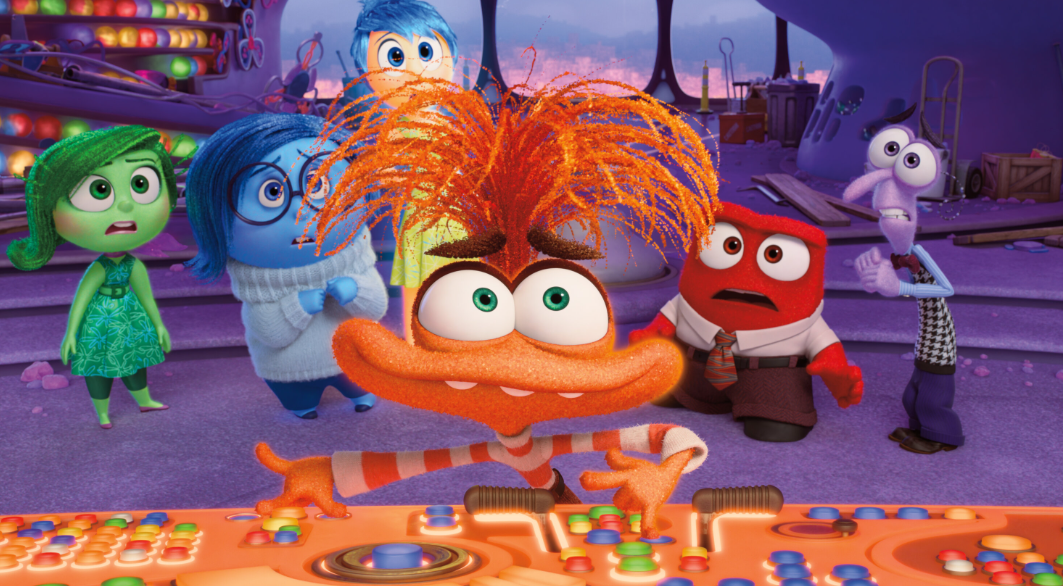The creation of emotions in Inside Out 2 is a remarkable example of the synergy between science and animation. The Pixar team collaborated with renowned psychologists and neuroscientists to design the characters representing the five core emotions: Joy, Sadness, Anger, Fear, and Disgust. The animators brilliantly transformed these complex psychological concepts into vibrant, relatable, and engaging characters. They used a combination of color, shape, and sound to visually represent each emotion. For instance, Joy is bright and vibrant, while Sadness is blue and droopy. This is not just aesthetically pleasing, but it’s also scientifically accurate as research suggests that humans universally associate specific colors with certain emotions.
Moreover, the storyline of Inside Out 2 is based on the scientific theory of emotional intelligence. The film showcases how our emotions interact and influence our actions and decisions, teaching viewers about the importance of emotional balance and acceptance of all feelings, even the uncomfortable ones. The movie also provides a simplified but accurate representation of how our brains store and recall memories, and the role emotions play in this process. The concept of ‘core memories’ that shape our personality islands in the film is a nod to the psychological theory of schema, which suggests our past experiences and memories significantly influence our present behavior and beliefs.
One of the most striking features of Inside Out 2 is the depiction of abstract thought. The animators have creatively visualized this complex cognitive ability through a sequence where the characters are broken down into abstract shapes. This unique portrayal is not only visually engaging but also aligns with the scientific understanding of abstract thinking as a process of breaking down complex ideas into simpler, more manageable elements.
Pixar also collaborated with child psychologists to accurately portray the psychological turmoil and growth of adolescence. The film showcases how the emotional landscape of the protagonist, Riley, changes with age. This is based on research suggesting that as children grow, their emotional understanding and experiences become more complex and nuanced. The film’s portrayal of how Riley’s emotions evolve, interact, and sometimes conflict, provides a realistic representation of the emotional development during adolescence.
Lastly, Inside Out 2 also explores the concept of emotional suppression and its impacts. It shows how suppressing emotions, particularly sadness, can lead to emotional numbness, depicted through the ‘grey’ scenes. This reflects the psychological theory that suppressing negative emotions can lead to reduced experience of positive emotions as well.
In conclusion, the animation and narrative of Inside Out 2 are deeply rooted in scientific knowledge about emotions, cognition, and psychological development. The film takes these complex theories and presents them in a simple, engaging, and relatable way, making it not just an entertaining watch but also a unique educational tool. The science behind the animated emotions in Inside Out 2 offers a creative and accessible platform to understand and discuss mental health, emotional intelligence, and psychological well-being.

Did you ever think a children’s movie about neuroscience wouldn’t work? Inside Out 2
You might be skeptical about the idea of a children’s film focusing on the complex field of neuroscience, but the sequel to the highly successful animation, Inside Out, is a testament that it is possible. Inside Out 2 brilliantly navigates the intricate labyrinth of the human mind, making it not only engaging but also educational for its young audience. The movie continues to follow the story of Riley’s emotions, Joy, Sadness, Fear, Anger, and Disgust, as they guide her through the challenges of adolescence.
Using a blend of vibrant animations and compelling storytelling, the film manages to simplify the concept of neuroscience, making it digestible for children. The characters personify different aspects of the human psyche, offering an insightful perspective on emotional intelligence and mental health. In a society where these topics are often considered taboo, Inside Out 2 bravely breaks the mold, making it an essential watch for children and adults alike.
The movie artfully balances entertainment and education, making complex scientific concepts accessible and enjoyable. It’s a masterstroke of creative genius that serves as an effective tool for initiating conversations about mental health and emotional well-being in a child-friendly manner. Even without delving into the realm of morality or legality, Inside Out 2 stands as an innovative children’s movie that successfully merges neuroscience with entertainment. A delicate blend of humor, drama, and suspense, this film serves as a powerful catalyst for nurturing emotional intelligence in children, all while providing a wholesome cinematic experience.
How many emotions are depicted in the film? Inside Out 2
Inside Out 2, a highly acclaimed animated film, delves deep into the emotional universe of a young girl, Riley, creating a vibrant, colorful depiction of her internal landscape. The film ingeniously personifies five primary emotions that control Riley’s mind: Joy, Sadness, Fear, Disgust, and Anger. Each emotion is characterized with unique personalities and colors. Joy is depicted as a radiant, golden figure, Sadness as a tearful blue character, Fear as a skittish purple entity, Disgust as a green, snobbish persona, and Anger as a red, fiery character. Their dynamic interplay and conflicts shape Riley’s behavior, decisions, and overall emotional wellbeing.
While the film primarily focuses on these five emotions, it also subtly hints at the existence of many more complex feelings. It suggests that emotions can merge to form new ones, like the bittersweet blend of Joy and Sadness in a single memory, indicating the existence of multifaceted feelings like melancholy. Inside Out 2 also explores the concept of developing emotional maturity, where Riley learns to feel and express her emotions in a more nuanced manner as she grows older.
Moreover, the film beautifully demonstrates that all emotions have their significance and place in our lives, even the ones typically viewed as negative. It showcases how Sadness, for instance, has an essential role in empathy and understanding, and Anger can drive us to stand up for ourselves when necessary. With its brilliant narrative, Inside Out 2 not only provides an entertaining experience but also opens up a profound conversation about the complexity of human emotions. It underscores the importance of acknowledging and expressing our feelings, making it an emotionally intelligent film that resonates with audiences of all ages.
What insights does the film offer about the emotion of embarrassment? Inside Out 2
The film “Inside Out 2” provides a profound exploration of the emotion of embarrassment, delving into the intricate ways it can shape and influence an individual’s thoughts, behaviors, and interactions with others. The film uses its unique narrative style and animation capabilities to visualize the internal emotional processes that drive embarrassment. It demonstrates how this emotion is often sparked by social situations, particularly those involving perceived mistakes or social faux pas. Viewers are led to understand that embarrassment is not just a fleeting feeling but can have lasting impacts on a person’s self-esteem and self-perception.
Furthermore, “Inside Out 2” highlights the interplay between embarrassment and other emotions, such as fear and sadness, showcasing how these emotions can amplify each other and escalate the individual’s emotional distress. The film also reveals that embarrassment can act as a form of self-regulation, steering individuals to conform to social norms and expectations to avoid experiencing this uncomfortable emotion in the future.
Perhaps one of the most striking insights offered by the film is the role of empathy in mitigating embarrassment. It shows how understanding and empathetic responses from others can help dissipate the intensity of embarrassment, promoting emotional healing and resilience. This aspect of the film underscores the importance of fostering empathy and compassion in our interpersonal interactions, particularly when dealing with individuals in the throes of embarrassment.
In essence, “Inside Out 2” paints a nuanced picture of the emotion of embarrassment, showing its potential to stir emotional turmoil, but also its capacity to foster growth, resilience, and social harmony. It invites viewers to reflect on their own experiences of embarrassment and encourages a more compassionate, empathetic approach to this often misunderstood emotion.

Is envy portrayed as a crucial emotion? Inside Out 2
In the sequel to the widely acclaimed Pixar film “Inside Out,” “Inside Out 2” delves deeper into the complex world of human emotions, with envy playing a significant role. The first film introduced audiences to the concept of emotions personified as characters, such as Joy, Sadness, Fear, Disgust, and Anger, that control a young girl, Riley’s, actions and reactions. In the sequel, the character of Envy is introduced, adding another layer to the emotional landscape that the creators have crafted.
Envy, in this context, is not merely a filler or a background character but instead, it is portrayed as a crucial emotion that heavily influences Riley’s behavior and decision-making process. The narrative of the film explores how envy can affect personal relationships and self-perception, leading to conflicts and dilemmas that can only be resolved through understanding and acceptance of this emotion.
The film illustrates that, although envy is often seen as a negative emotion, it is a natural part of the human emotional spectrum and plays a significant role in our lives. Just as Joy and Sadness learn to coexist and understand each other’s importance in the first film, “Inside Out 2” depicts Envy’s journey to acceptance and illustrates the necessary balance of all emotions.
The sequel beautifully captures the essence of envy, demonstrating its potential to fuel ambition and personal growth when properly understood and managed. Thus, “Inside Out 2” not only acknowledges envy as a crucial emotion, but also challenges audiences to explore their understanding and relationship with this often misunderstood emotion.
How is a complex feeling like anxiety made relatable and appealing for children? Inside Out 2
Making complex emotions like anxiety relatable and approachable for children is a challenging task, but the sequel of the animated movie Inside Out, Inside Out 2, accomplishes this beautifully. The movie employs a unique and visually stunning method of representing emotions as colorful characters, each embodying a different feeling. In this case, the character representing anxiety is sketched with a greyish-blue hue, a subtle symbolism for the often clouded and distressing nature of this emotion. This character is neither menacing nor scary, but rather a sympathetic figure that children can relate to and empathize with.
The narrative carefully weaves in scenarios that kids commonly encounter, such as moving to a new school or feeling left out at a birthday party. The anxiety character is brought into the spotlight in these instances, showing its role in these challenging situations. The character comes alive with a flurry of lines and squiggles when the protagonist feels nervous, making the abstract concept of anxiety tangible and visually understandable for children.
Moreover, the movie also emphasizes the importance of anxiety as a necessary emotion. The anxiety character is not portrayed as an antagonist, but rather a part of the protagonist’s emotional toolkit, highlighting that it’s okay to feel anxious sometimes. This approach not only makes the complex emotion of anxiety relatable but also helps children understand that it’s a natural part of life, thus reducing any associated stigma.
The film also uses humor and tender moments to lighten the intensity of the subject. The anxiety character, while worrisome, also has moments of comic relief, making it appealing and less intimidating for children. Inside Out 2, therefore, succeeds in making a complex emotion like anxiety both relatable and appealing for children, paving the way for more open conversations about mental health.
Was it challenging to represent anxiety in the film? Inside Out 2
Portraying anxiety in the film Inside Out 2 was indeed an arduous task. The filmmakers had the daunting challenge of visually conveying a complex mental state that is typically internalized and uniquely experienced by every individual. The crux of the challenge was to represent it in a manner that was both accurate and relatable, encompassing its many dimensions and shades. The creators had to delve deep into the realms of psychology to unravel the myriad layers of this emotion. They had to tread a delicate balance between educating their audience about this mental state and not stigmatizing or oversimplifying it.
The character of Fear, who is responsible for safety and caution, was used to portray anxiety. However, it was imperative to differentiate between the two; fear being an immediate response to a perceived threat, and anxiety being a more prolonged, constant state of worry about potential threats. The filmmakers had to ensure that Fear’s reactions were not only a response to immediate threats but also embodied the anticipatory nature of anxiety.
Additionally, the task of depicting anxiety in a family-friendly film presented its own set of difficulties. The creators had to be careful not to depict it as something terrifying or overly negative, but rather as a natural part of human experience that can be managed and coped with. They made use of metaphorical representations, color gradients, and changes in the character’s voice tone and body language to subtly indicate elevated levels of anxiety.
The representation of anxiety in Inside Out 2 was indeed a challenge, but the filmmakers’ thoughtful and sensitive approach towards this complex emotion resulted in a depiction that was both informative and empathetic. It allowed audiences of all ages to gain a better understanding of anxiety, and it showed that even challenging emotions have a purpose and contribute to our overall well-being.
How did the character of Ennui make it into the film despite seeming obscure? Inside Out 2
The inclusion of the character Ennui in the sequel of the acclaimed animation film “Inside Out” was a creative decision that appeared to be shrouded in mystery, considering the character’s obscurity. The creators of “Inside Out 2” were faced with the challenge of introducing a new character that would not only resonate with the audience but also seamlessly blend into the narrative.
The character of Ennui, symbolizing a state of listlessness and dissatisfaction arising from a lack of occupation or excitement, was an unconventional choice. However, the filmmakers opted to use him as a vehicle to explore more complex emotional landscapes that children encounter as they grow up.
The decision to include Ennui was a carefully strategized move to keep the narrative engaging and emotionally charged, while introducing a new depth to the story, making it more relatable for the maturing audience. Despite Ennui being obscure in comparison to the original characters, his addition in the sequel was executed so smoothly, it seemed as if he was always meant to be there. The creators managed to maintain the balance between the familiar characters and the new ones, ensuring that the narrative did not lose its original charm.
Ennui’s presence in the film served as a testament to the filmmakers’ ability to evolve their storytelling to incorporate more nuanced emotions, while continuing to captivate their audience and stay true to the essence of the series. The successful integration of Ennui into “Inside Out 2” demonstrated that even seemingly obscure characters have the potential to enrich the narrative and deepen the emotional resonance of a film.

If Inside Out 3 were to happen, which emotions would you like to see introduced?
If Pixar were to announce Inside Out 3, it would be intriguing to see the introduction of new emotions that could further explore the complexity of the human emotional spectrum. Firstly, the emotion of “Empathy” could be a fascinating addition. As one of the most vital emotions in fostering understanding and compassion among individuals, Empathy could serve as a bridge between the existing emotions, helping them to connect and collaborate more effectively.
Secondly, “Jealousy” would be an interesting emotion to introduce. As a common emotional experience, it could bring a new dynamic to the interplay among the emotions and create compelling conflict within the narrative. Additionally, the emotion of “Curiosity” could also add a unique flavor. It could drive the exploration of new thoughts and memories, thus leading the story into uncharted territories.
Lastly, introducing an emotion like “Ambivalence” could heighten the depth of the film. Ambivalence, being the experience of having mixed feelings, could offer a nuanced perspective on how we sometimes feel more than one emotion at the same time, and how we navigate such complex experiences. Overall, the inclusion of these new emotions in Inside Out 3 could enrich the storyline, make it more relatable, and provide a broader depiction of the human emotional landscape.
